You can view this information in two different ways. Our alphabetical list provides information on the status of each species within the harbour, finder dates and names, photos and favoured locations. By clicking on the Systematic List button you will be presented the full Poole Harbour systematic list which includes status of species, pending records and historical accounts.
To date, 333 species have occurred and have been accepted within the Birds of Poole Harbour boundaries. A further 11 distinct subspecies have also been seen. In addition, we have two species/subspecies which have been recorded, but are awaiting acceptance by the appropriate records panel.
There are a handful of historical records, for which there is currently insufficient information to allow their inclusion onto the Poole Harbour list, but are believed to be genuine records. They are listed at the end of the list.
Finally, there are a number of feral or escaped species that have been recorded within the Birds of Poole Harbour boundaries. They are included for completeness, but are not included on the Poole Harbour list.
We would be interested in hearing details of any species that do not appeared on this list.
The Birds of Poole Harbour systematic list is a PDF which you can view by clicking on the button below. It was last updated on December 2019.
Full Poole Harbour Systematic List
Stercorarius longicaudus
Vagrant
This is the rarest of our Skuas with very few records in Dorset each year, mainly in autumn.
There are only 3 records for the harbour, however given the frequency of sightings at Hengistbury Head, at the eastern end of Poole Bay, we might have expected more. Anyone with the patience to watch the sea at Branksome Chine for long enough might eventually be rewarded…….
2 in Oct 1891 (shot)
1 west on 24th Sep 1982 at Canford Cliffs
Juv west on 31st Aug 1998 at Hartland Moor (S.Robson, R. Howell). This bird occurred in a SE gale and had presumably entered the harbour at Sandbanks. It was seen to fly off toward Creech Gap having passed over the shocked observers heads.
1 dark morph juvenile on Aug 21st 2020 west from Branksome Chine during strong winds (M.Constantine)
1 west across Poole Bay on October 2nd 2020 – (M.Constantine & G.Armstromg)
Aegithalos caudatus
Resident
Breeds all around the harbour, but easiest seen in August, September and October when large mixed tit flocks gather together and pass through the woodland in a big convoy. This phenomenon can occur anywhere, for example places such as Upton Country Park, Arne, Studland, Lytchett Bay, Holton Lee and Brownsea Island and can quite often consist of up to 10 species. Now also a frequent garden visitor to many urban and rural gardens around the harbour.
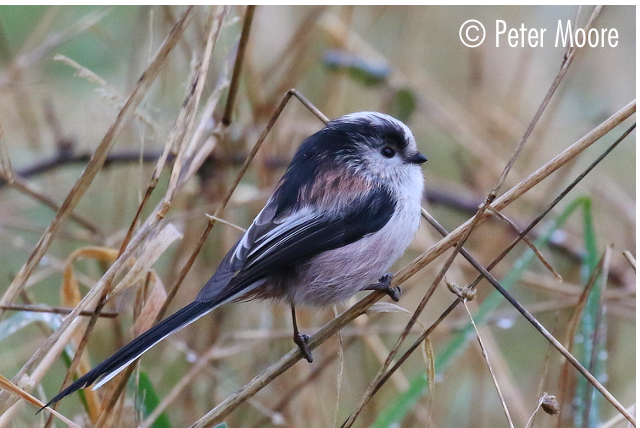
Pica pica
Resident
Found breeding right across the harbour, with semi large roosts of up to 100+ birds congregating in the winter at Hatch Pond.
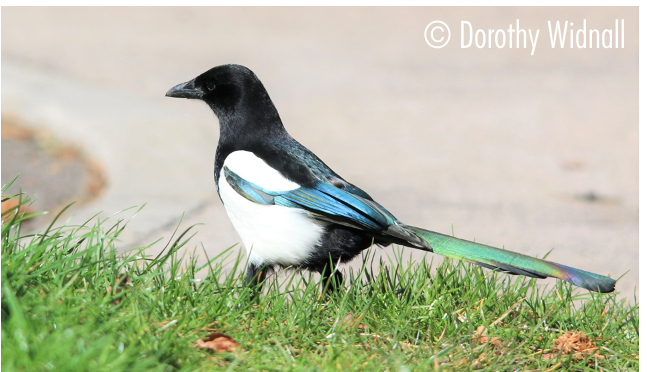
Anas platyrhynchos
Resident
“Presumed to breed on wetlands everywhere” Smith said in 1998. About a quarter of the Counties birds are in the harbour and numbers of birds in the harbour have not varied over the past sixty years. The largest resident flock is on the Frome at Redcliffe where there has been a summering flock of none breeding birds of around seventy for over twenty years. The harbour maximum is 1755 on the 12th November 1985. ‘Birds of Dorset’ states 1755 in Nov 1978. Otherwise as with the rest of the world the best place to find Mallard is the park. At one time one paired with a Mandarin duck on Hatch Pond.
Despite their affiliation with being ‘common’, recent WEBS data shows that less Mallard are actually present during the winter in harbour compared to 20 years ago. The average 5-year winter total population is 353 per winter.
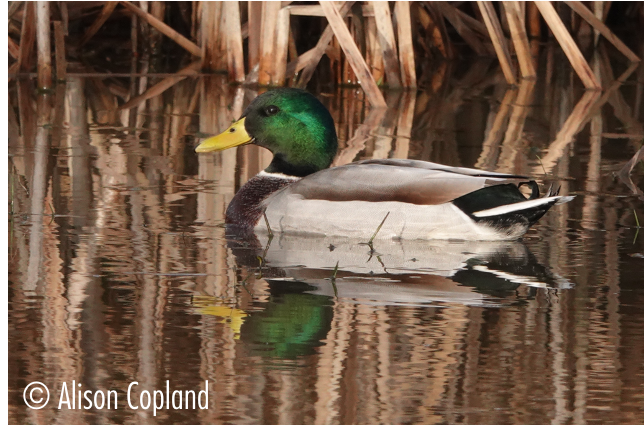
Aix galericulata
Scarce Feral Visitor
Secretive as they are, Mandarins probably used to breed in the harbour. If they did Creekmoor Ponds would have been favourable for exploring with 2 females at Creekmoor Ponds 3rd Jan 1997.
They used to be regularly recorded at Hatch Pond, Creekmoor Ponds and Poole Park . 1 pair bred at Broadstone Golf Course (outside the harbour recording area) in 2004 and up to 14 birds were present between August and Oct is that in the area of the same year.
A female visited Hatch Pond from 1997-1999 making this the best site to see Mandarin within Poole Harbour. Birds assumed to be from the breeding colony at Merley also got to Upton Country Park and Poole Park. A male was paired to a Mallard in Poole Park and was near the train shed through the spring of 1975. Another male was also released by Longfleet School in 1993 which seemed to disappear after 26th February 1995.
A recent record was of course the male which spent the 2018/19 winter period on the small Poole Park boating lake.
In recent years they’ve become regular breeders and over-wintering birds in the Piddle and mid-Frome Valley with confirmed breeding at Carey Secret Garden in 2021 and 2022. Plus, small groups of 3-8 individuals have been seen moving between Holmebridge and the Piddle Valley.
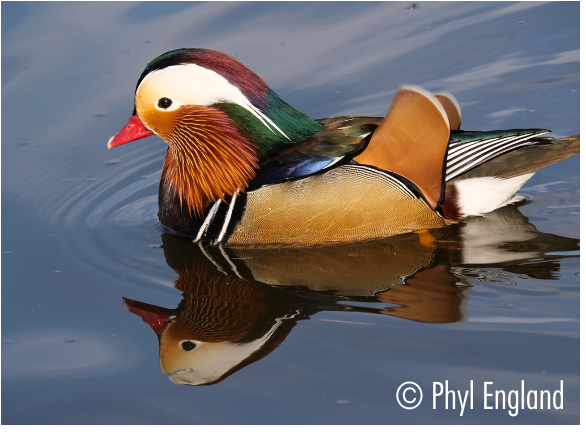
Puffinus puffinus
Summer Visitor & Passage Migrant
Scarce visitor, recorded annually in Poole Bay. Best looked for from Branksome or Flaghead Chines between May and July with with a high count of 70 there on 21st April 1999. Other records off Studland Bay occur too with the highest count of 93 was recorded in just 50 minutes, including one flock of 37, on the 11th July 2001 at Studland Bay. Other relatively large counts include 45 on 21st Jun 2007 and 38 on 15th June 2005. Sea watching out in Poole Bay from May to July in a south-east wind could/should produce Manx Shearwater. Recorded once inside the harbour on 7th Sept 1961.
Circus aeruginosus
Resident
Back in the late 1940s Poole Harbour had as many as 60% of the entire UK breeding population of Marsh Harriers with nesting recorded around Wareham Channel, Middlebere, Little Sea and Brownsea Island. 1949 saw the first signs of breeding at Keysworth and by 1954 there were five pairs breeding in the harbour at Little Sea, Keysworth, Middlebere and Brownsea. This gave a maximum number of birds in the harbour of 22 -10 adults and 12 young. However, breeding ceased in 1963 as the species suffered a catastrophic national decline and breeding wasn’t recorded again breeding in Poole Harbour until 2013 when a pair raised three young at Swineham. It was thought shooting, egg collecting, human interference and flooding of nest sites caused a decline back in 1963. Since 2013 one to two pairs nested successfully in the west Harbour area each year with a clear potential for more, although sadly in 2017 they had stopped again. Thankfully by 2022 1-2 pairs were attempting to breed with success of at least 1 pair in 2022 and 2023.
Winter numbers have increased with double figure roost peaks now recorded in most years and a maximum count of 31 in December 2022. The birds` use of specific roosting locations can vary and although the main sites are found in the Wareham Channel reed beds, alternatives may be favoured at different times by either individuals or groups, e.g. Lytchett Bay, Middlebere, the Wytch Channel and Hartland Moor. During the winter foraging Marsh Harrier can be seen at many sites including Middlebere, Lytchett Fields, Holton Pools, Arne and Swineham.
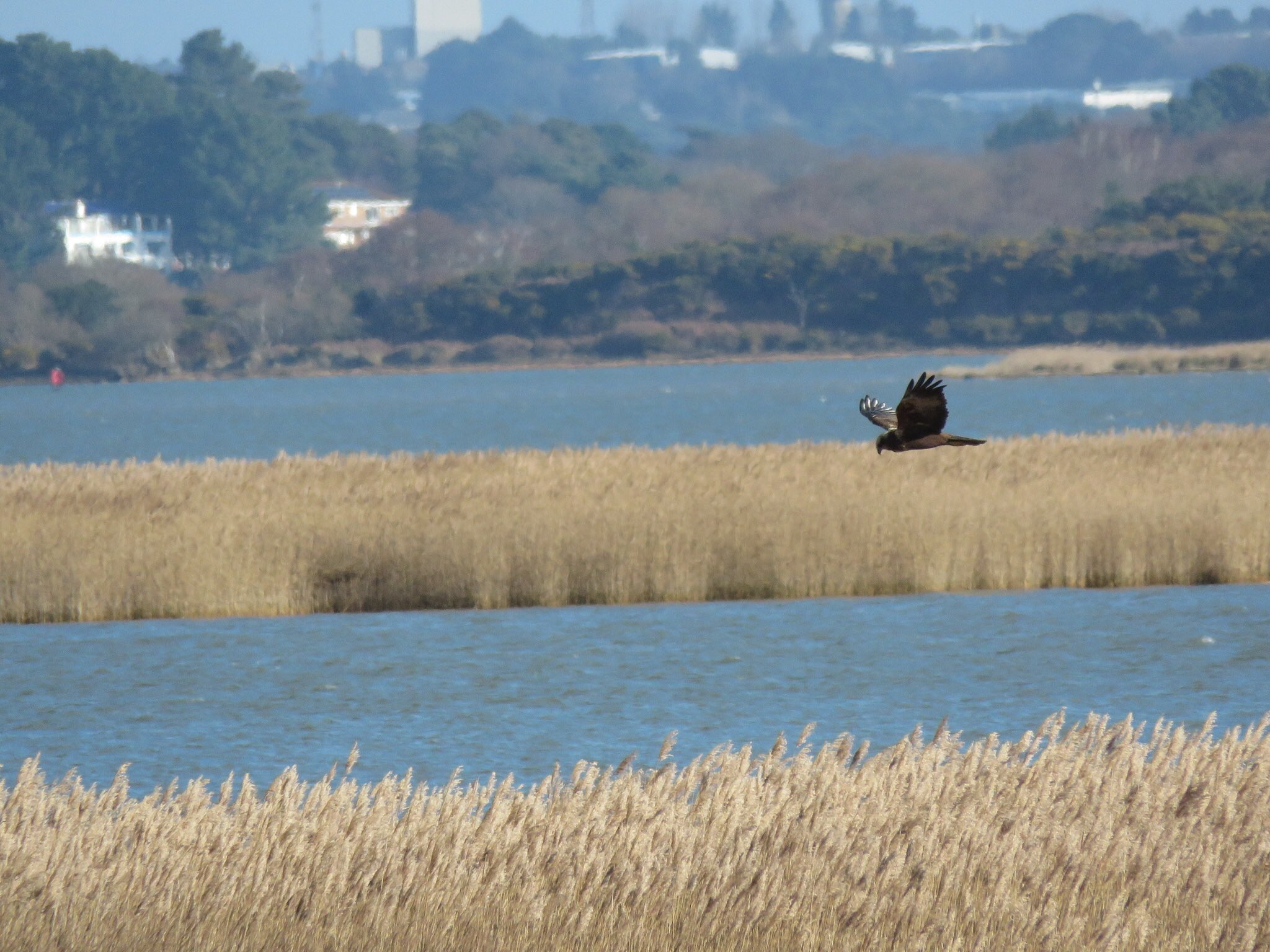
Poecile palustris
Scarce Resident
The 1987 – 1994 Tetrad breeding survey described the central and southern parts of Poole Basin as a stronghold for a species that was at that time widespread in Dorset. Between 1968 and 1993 the number of pairs at Arne increased from 2 to 15. Arne car park was a guaranteed location to find this species until at least 2010. The 2008-2011 National Atlas survey revealed a 27% national decline in the 20 years leading up to the survey, though local declines in Poole Harbour, in distribution at least, were not identified.
Acrocephalus palustris
Vagrant
A very, very rare bird in Dorset with only a handful of records, despite its abundance on the near continent as a breeding species. Poole Harbour only has 1 record but its thought/hoped they could become more frequent over the coming decade as populations across Europe increase and now people are more familiar with their song.
1 on May 9th 2009 at Hatch Pond. Sound recorded (E.Brodie)
1 on May 29th 2020 at Bestwall, Swineham. Sound recorded. (P.Moore)
Anthus pratensis
Resident
Breeds on all the local heathlands with good numbers at Arne, Studland and Godlingston. Numbers fluctuate in autumn and winter especially out on open heathland where numerous groups of 50+ birds spend the winter feeding together. Meadow Pipit migration in the autumn can be quite spectacular with counts of 500+ passing over various parts of the harbour in the right wind conditions. Early morning at North or South Haven and Ballard Down in September and October are good places to watch.
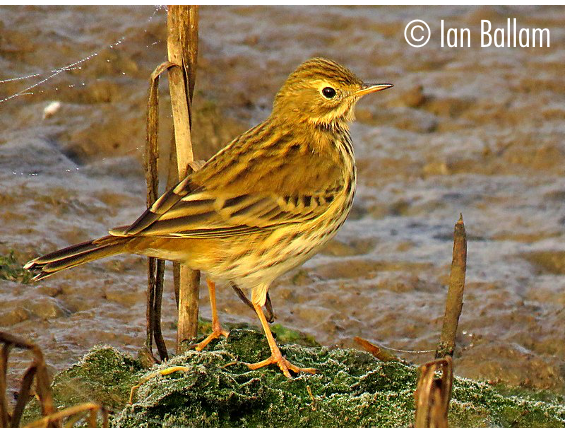
Carduelis flammea
Rare Visitor
Larus melanocephalus
Resident
Once a very scarce breeder, numbers have now soared with over 100 pairs breeding in the harbour. In the spring and summer they can be identified by their load cat like ‘meow’ as they fly to and from feeding sites. Their flight line takes them over the north-west of the harbour with Lytchett Bay and the Wareham channel seeing most records. In the winter birds are a bit harder to find within the harbour but hansom winter plumage birds can be seen feeding off the Studland Beaches mixed with other gulls. In spring many summer-plumaged birds can be found feeding along the shoreline of Whitley Lake and Baiter Beach on the low tide.
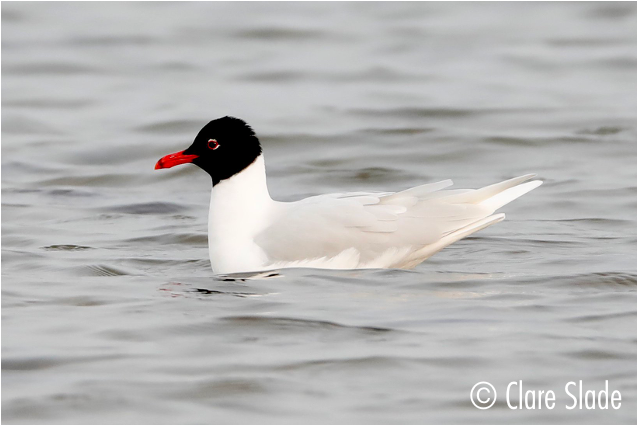
Hippolais polyglotta
Vagrant
Whilst Dorset occasionally attracts late spring migrants this has not yet been the case in the harbour. August is the peak month and Studland and Ballard Down the most likely areas to find one.
The western sibling to Icterine Warbler is an almost annual visitor to Dorset. There have only been 3 blank years since 1957. In 1979 there were 17 records but in most years only low single figures are found. In the harbour it remains a very good find, a ‘twitchable’ individual would be very welcome.
1 on 17th Aug 1975 at Studland (S.J.Aspinall)
1 on 1st Aug 1977 at Little Sea, Studland
1 on 25th Aug 2001 at Ballard Down (J.A.Lidster et al)
1 on 27th Aug 2001 at Swineham GP (N.Hull, J.Hull et al)
1 from 20th – 21st Aug 2002 at Ballard Down (I.Prophet et al)
1 on 13th Sep 2014 at Greenland’s Farm, Studland (Mark Constantine, Mo Constantine)
1 on 11th Aug 2015 at South Haven, Studland (G Armstrong, S Morrison, SW Smith)
1 on 14th Aug 2015 at Lytchett Bay (I Ballam, IM Lewis)
1 on 12th Aug 2017 at Greenland’s Farm (M Constantine)
1 on 15th – 28th June 2021 at Middlebere, Harrier Hide. A male in full song (I.Duckworth & P.Morton)
There is also a report that was never submitted or assessed. It is included here for completeness and any further information would be welcomed. 1 on 4th Sep 2004 at South Haven, Studland;
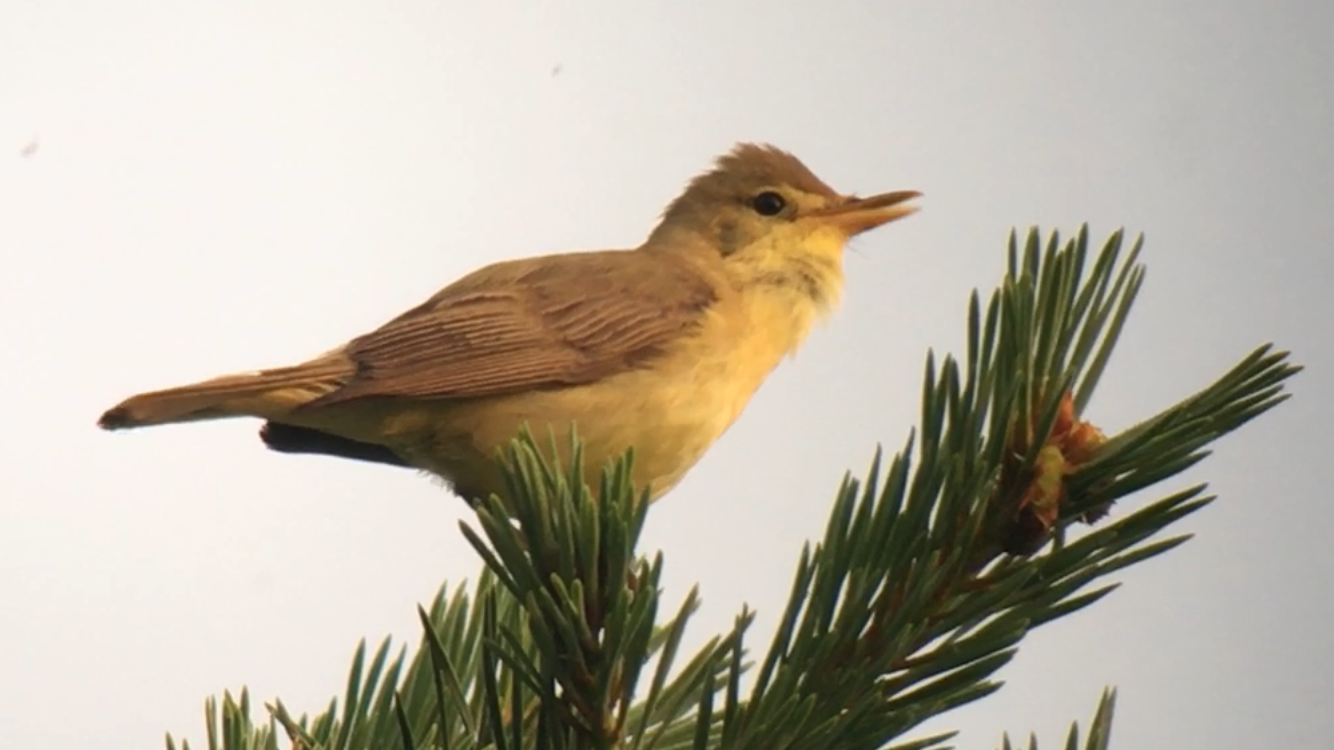
Falco columbarius
Passage Migrant & Winter Visitor
Merlin are best looked for in autumn and winter over heathland and tidal inlets around the harbour, when several birds may gather to take advantage of migrant passerine passage and over-wintering pipit flocks. During November, December and January individuals can be seen hunting most often in the Middlebere / Hartland Moor area although single birds can appear over any open ground where small prey is readily available, e.g. the Studland heaths, the Arne heaths, Arne Moors, Lytchett Fields, Brownsea Island lagoon and Lytchett Bay.
Wintering Merlin will roost either in bushes or on the ground in wetland and heathland areas. Two or three birds may be seen together wherever this occurs. They can sometimes be seen alongside Hen Harriers at the end of the day when the two species may hunt in tandem before settling for the night.
A historic maximum of 4 were logged at a roost near Wareham on 26th March 1987. The earliest record was on 6th September 1970 and the last on 27th June 1961 at Stoborough.
There’s not much change in status over the last sixty years for example in 1963/4, when you would expect it to be at its worst after the cold winter of 1962/63 there were 5 records up to March and 3 from October December.
A female found dead on Hartland in November 1995, had been ringed in Tayside on 25th June 1995.
Turdus viscivorus
Resident
Seen in ones and twos around the harbour with Greenlands Farm, Arne, Holton Lee and Studland being reliable sites. Recently post breeding flocks of up to 50 birds frequent Arne in late summer/early autumn with other post breeding flocks occurring at sites including Canford Heath and the Corfe River Valley.
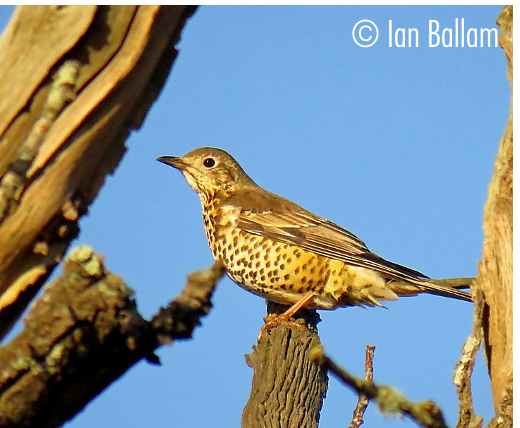
Circus pygargus
Scarce Passage Migrant
Montagu`s Harriers have tended to be seen either in spring (May is the peak month) or late summer (August) as occasional individuals passed through the area on the way to and from established nesting areas. These included Dorset up to 2004 although not since. As a consequence records of this species have become less frequent. As this species has become scarcer, Pallid Harrier is becoming more frequent, in a British context if not yet a Dorset one. Observers of suspected Montagu’s Harriers in the future need to bear this prize in mind, especially in autumn.
Sightings tend to be from along the southern shores of the harbour with Arne/Hartland and Studland being the favoured areas.
The earliest record is of a ringtail over Godlingston Heath on 15th April 1983. The latest, is an old record which is particularly notable, 1 on 28th Dec 1959 in “Poole Harbour” (BoD, GG, 2004)
All recent records:
Ringtail on 6th and 7th May 1967 at Arne (H.G.Alexander)
Ringtail on 7th May 1967 at Ninebarrows Down (S.P.W Corbett) possibly same as above?
Ringtail on 18th to 23rd May 1969 at Hartland Moor/Arne (P.Hawkins et al)
Ringtail on 23rd May 1969 at Godlingston Heath (P Hawkins et al)
Male on 26th May 1969 at Arne (B.Pickess)
Melanistic ringtail on 10th May 1981 at Godlingston Heath
Ringtail on 15th Apr 1983 at Godlingston Heath
Ringtail on 25th Apr 1988 at Poole Hospital which stunned the observer as he cycled past (Ma Constantine)
1 on 2nd Sep 1990 at Arne
Male on 22nd Jul 1991 at Upton CP
1 on 23rd and 25th Jul 1993 at Bourne Bottom, Parkstone
Ringtail on 26th Apr 1995 at Lytchett Bay (S.Robson, N.Symes)
Ringtail on 3rd Aug 1996 at Keysworth (I.M.Lewis, S.Robson et al)
Ringtail on 28th Aug 1996 at Ower (H.G.Wood-Homer)
Male on 26th Jul 1997 at Arne (I.H.Southworth)
Juv on 9th Oct 1998 at Middlebere (Ma.Constantine)
Ringtail on 6th May 2000 at Studland (Mo.Constantine)
Ringtail on 13th May 2000 at Arne Moors (Ma Constantine & Mo Constantine)
Ringtail on 13th May 2003 at Bestwall (I.Prophet)
Female east on 25th Aug 2007 off Ballard Down (S.W.Smith)
2nd Cal yr Male from 13th to 20th May 2008 at Harland Moor (J.A.Lidster et al)
1 juv on Coombe Heath, Arne on 31st Aug 2012 (J.Mitchell)
1 juv over Lytchett Bay and Lytchett Fields RSPB on 31st Jul 2017 (I.Ballam, G.Owen). This is the second record for the site.
Gallinula chloropus
Resident
Moorhen are very common around the harbour and breed in Poole Park, Little Sea, Upton Country Park, Brownsea, Arne, Holton Heath, Brands Bay, Lytchett Bay, Wych, Middlebere, Greenlands Farm, Ower, Hatch Pond, Creekmoor Ponds and along both rivers. Could be between 50 and 250 breeding pairs in the 100 miles + of suitable habitat in Poole Harbour and yet the maximum count for the harbour is only 40 during recent WeBS counts. The maximum for a single site is 39 in Poole Park in March 1987.
In December 1977 ‘Boys’ mentions in the Dorset Bird Report a “melanistic bird noted at Holton.” Also interesting is a bird “ringed in Poole on 10th December 1967 as a 1st year bird and re-caught at the same site on 23rd February 1968. It was then killed by a cat on 20th June 1968 at Bad Schwartau, Schleswig Holstein in Germany”.
It’s also been recently learned that Moorhen are incredibly active at night either migrating or possibly carrying out territorial flights. Nocturnal listening stations located at different sites around the harbour have sound recorded many Moorhen passing over areas at night, including strange areas like Poole Town Centre and the headland at Ballard Down.
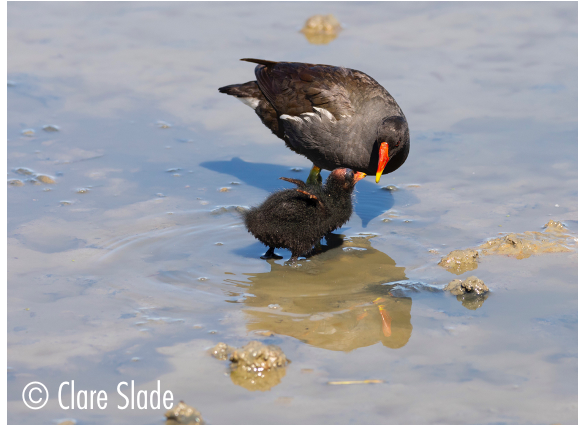
Cygnus olor
Resident and winter visitor
There about 10-20 breeding pairs scattered throughout the harbour each year. There are usually a pair or two on the River Frome, River Piddle, Brownsea Island, Hatch Pond, Poole Park, Brands Bay, Little Sea, Ham Common, Arne, Middlebere, Swineham and Holes Bay.
There is also a non and post-breeding herd at the mouth of the Piddle in the Wareham Channel that builds up in the summer and regularly holds 150 birds, with a maximum of 219 on the 16th August 1999. The water meadows besides the Frome between Worgret and East Holme also hold non breeding Mute Swan with 44 birds there in the 1978 census. Young Mute Swans arrive here to moult in the winter from Abbotsbury and other local breeding populations may also be moving back and forth across the channel. A bird ringed in Poole Park on 15th January 2000 was found dead near Charbourg in France on 9th Sept 2002.
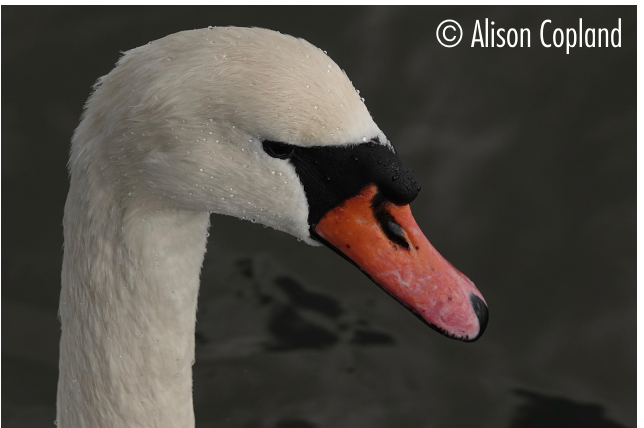
Nycticorax nycticorax
Vagrant
This species was dropped from the BBRC list in 2002 due to its increasingly frequent occurrence. It is remarkable that there are so few records in Dorset. There have now been a little more than 20 Dorset records but only 4 in Poole Harbour. Surely more will be found over the coming years, perhaps at Swineham or Little Sea, Studland? Night Heron also now breed (in very small numbers) on the Somerset Levels, so passage birds could also increase. With the last two occurring on May 2nd 2020 and May 3rd 2021, there’s no doubt when to keep your eyes and ears open in Poole Harbour.
1 shot in mid November 1891 near Seymers on Brownsea
Adult on 8th November 1949 at Wareham Water Meadows
1 on May 2nd 2020, 6 calls logged during a night recording session in Poole Town Centre (Mark Constantine and Magnus Robb)
1 on May 3rd & 11th 2021 at Carey Secret Garden in the Piddle Valley, Wareham (M&M Constantine)
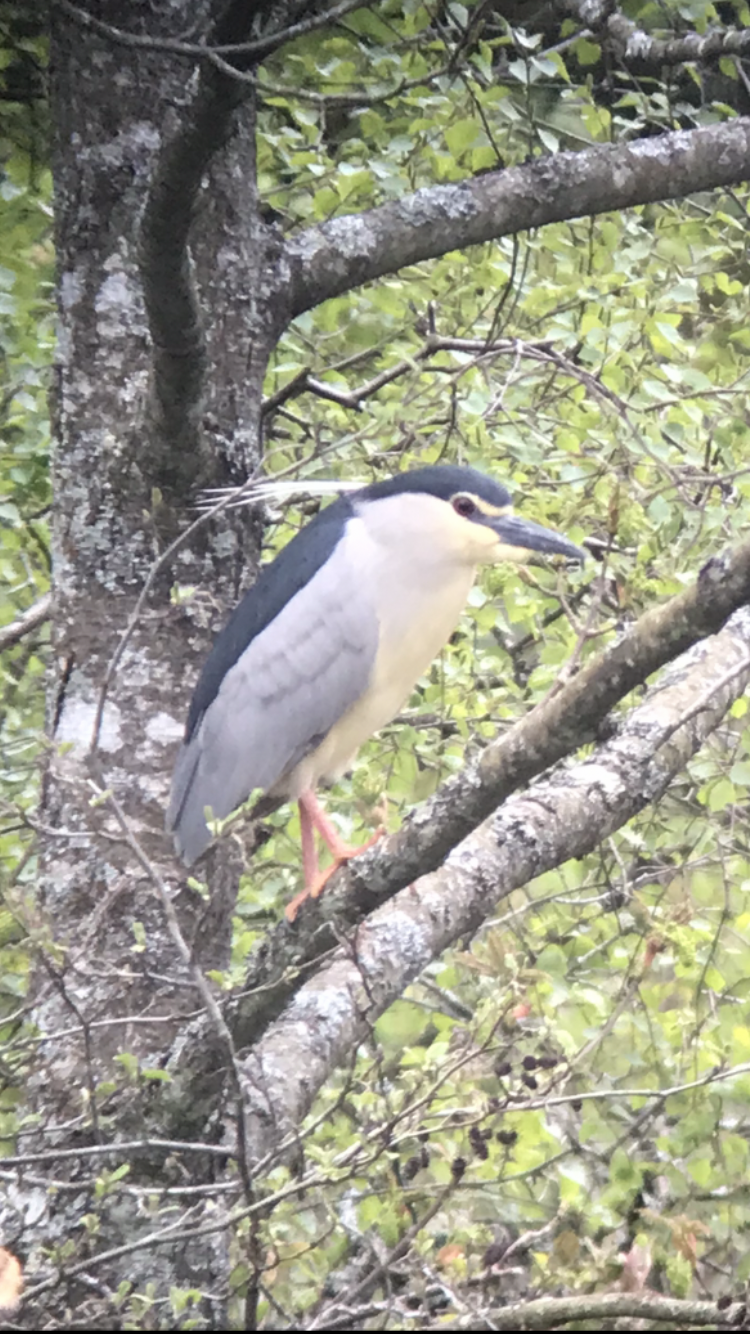
Luscinia megarhynchos
Scarce Passage Migrant
The number of Nightingales in Britain has declined by 90% in the last 40 years and their range has also retracted by 43%. It is therefore not surprising that its occurrence in the harbour has also reduced. With this in mind, its sad to state that we have now too lost our breeding Nightingale here in Poole Harbour from Challow Hill, Corfe.
In the 1960’s and 70’s breeding occasionally occurred around Brownsea, Studland, Corfe Castle, Holton Heath. During the 80’s breeding records disappeared and it looked like we had lost the species as a breeding bird in the harbour. In the 90’s occasional records came from Stoborough but breeding was not proven, Bushey and in 2000 a pair bred at Studland Golf Course. In 2009 breeding birds were discovered near Corfe Castle and at least two pairs bred there up until 2016 but none have been heard since.
The species is best detected on spring migration as it is likely to be singing and the following records have been logged since 2000
Given Nightingale’s skulking nature it is not surprising that it is rarely recorded on autumn migration. In fact the only records that we could find are as follows:
The species is best detected on spring migration as it is likely to be singing and the following records have been logged since 2000
1 on 7th Aug 2000 at Ham Common
1 on unspecified dates 2001 at Stoborough Heath
1 on 8th May 2002 at Ham Common
1 on 19th Apr 2003 at Sandford
1 on 20th Apr 2003 at Fleets Lane, Poole
1 on 30th Apr 2004 at Ham Common
1 on unspecified dates 2006 at Stoborough Heath
1 on 21st Apr 2007 at Holes Bay
1 on 20th Apr 2008 at Ballard Down
1 on 24th Apr 2011 at Upton CP
1 on 1st May 2012 at Lytchett Bay
1 on 5th May 2014 at Stoborough Heath
1 between 23rd Apr-5th May 2016 at Corfe Ridgeway, Challow Hill.
Given Nightingale’s skulking nature it is not surprising that it is rarely recorded on autumn migration. In fact the only records that we could find are as follows:
1 on 15th Aug 1984 at Brownsea
1 on 27th Aug 1991 at Lytchett Bay
1 on 28th Aug1993 at Keysworth (trapped)
1 on 12th Sep 2009 at Greenlands Farm.
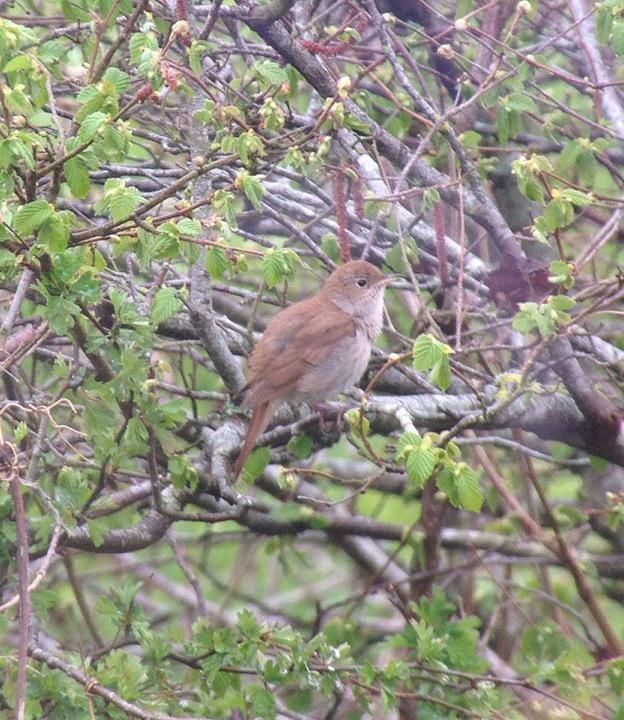
Caprimulgus europaeus
Summer Visitor
Any heathland surrounding the harbour will hold good numbers of Nightjar. Arne, Godlingston, Slepe Heath, Canford Heath, Holton Lee, Studland, and Hartland Moor are all top sites. Arne had 47 pairs in 2018 and birds can arrive back in late April, but the main bulk of activity doesn’t start until mid to late May and will carry on all the way through June and July, with juveniles hanging on into August and September. There is truly no better birding experience in Dorset than watching Nightjar on your local heathland on a balmy hot summer evening.
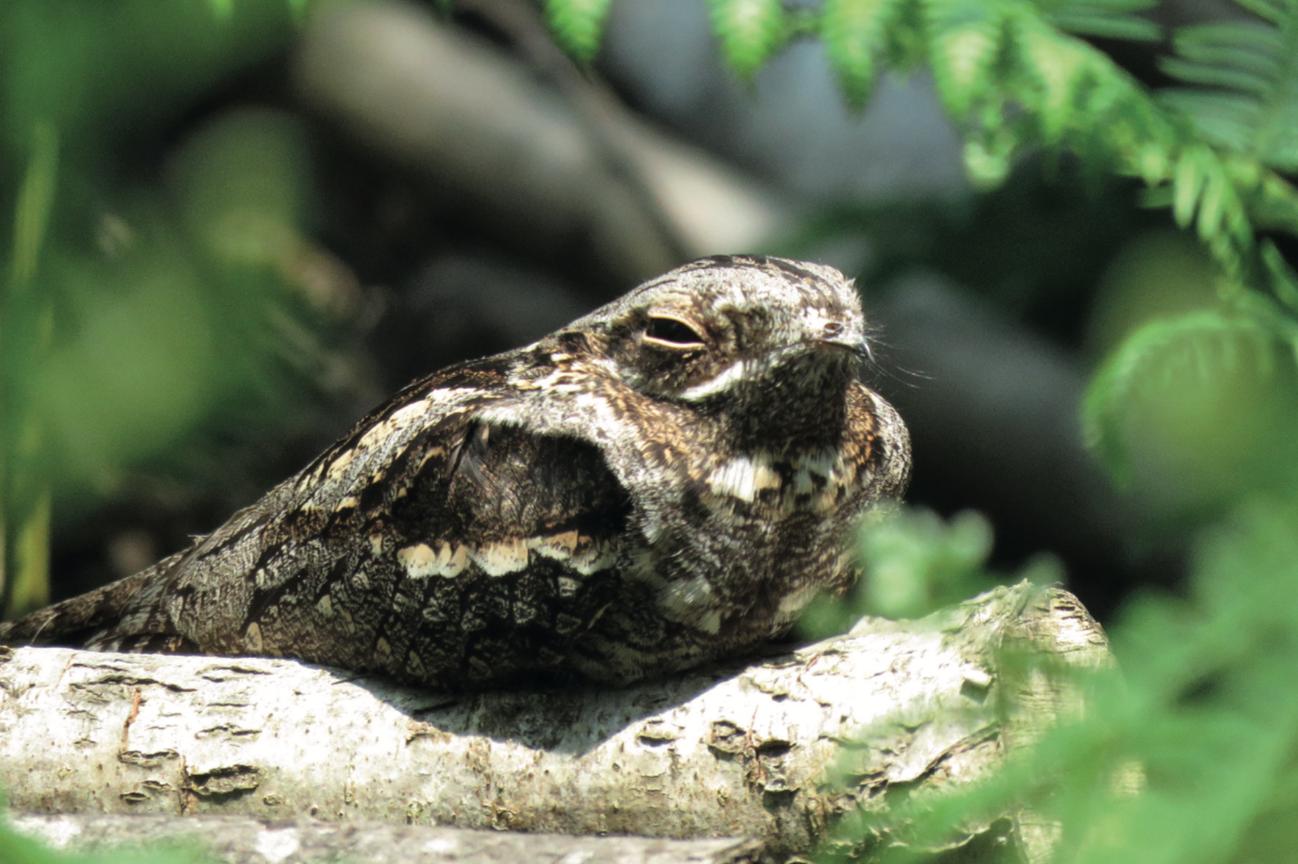
Nucifraga caryocatactes
Vagrant
In 1968 there was a massive irruption of the slender-billed race N.c.macrorhynchos from Siberia into Britain involving c315 birds. Seven of these occurred in Dorset. Oh how we would welcome another such event!
1 from 13th – 21st September 1968 on Brownsea
Sitta europaea
Resident
Breeds at Arne, Brownsea, Hatch Pond, Holton Lee, Upton Heath, Upton CP and probably many more sites. Arne and Holton Lee gives great views as they come and feed on the feeders in the car park usually only 2-3 meters away.

Anthus hodgsoni
Vagrant
Ballard Down 1 on 12th Oct 2015 (Nick Hopper, Paul Morton). Identified only from a sound recording made during a visible migration watch, this constitutes Dorset’s first away from Portland.
Emberiza pusilla
Vagrant
Prior to 2015 there had only been one record of Ortolan Bunting within the Poole Harbour area.
1 on 4th Sept 2007 Glebelands, Studland (N.Hopper)
Then in 2015 sound recording efforts at prominent migration spots such as Glebelands and Ballard Down produced another record of one passing by with Linnet.
1 sound recorded on Sept 19th 2015 Glebelands, Studland (P.Morton)
Then, in 2016 everything changed with the setting up of a nocturnal listening station in Old Town Poole where the monitoring of night-time migrants could be accurately assessed on a nightly basis during peak migration times. As autumn migration got under way big movements of Tree Pipit and wader species were a nice insight as to what was going on above our heads whilst we were sleeping, but the most incredible discovery came along at 2:24am on August 23rd when an Ortolan Bunting passed over the listening station. Its well documented that Ortolan Bunting are a vocal night time migrant in mainland Europe, within their range. But over Poole Town Centre? Over the following 21 nights another TWELVE Ortolan Bunting were recorded migrating over the listening station bringing the total to 13. Dates Ortolan Bunting were recorded flying over the nocturnal listening station were…..
1 on 23rd August 2016 @ 2:47am
1 on 24th August 2016 @ 2:00am & 2:40am
1 on 25th August 2016 @ 1:31am, 2:27am & 3:08am
1 on 27th August 2016 @ 2:03am
1 on 29th August 2016 @ 9:37pm
1 on 30th August 2016 @ 3:34am
1 on 1st September 2016 @ 2:33am
1 on 5th September 2016 @ 8:53pm
1 on 7th September 2016 @ 2:46am
1 on 12th September 2016 @ 1:12am
The discovery was made in partnership with the Sound Approach and a full write up of the discovery can be found on the Sound Approach website titled Things that go Plink in the night
In addition to the night migration discovery another Ortolan Bunting was seen and heard flying along Soldiers Road on September 3rd 2016 at 8:10am
2017
Poole 3 sound-recorded at night on 3rd Sep.
2018
Lytchett Bay 1 nocturnal migrant at 2300 on 27th Aug (P Morton).
2019
Corfe Castle Single nocturnal migrants heard over Corfe Gap on 21st & 27th Aug (P Morton).
2020
Stoborough 1 nocturnal migrant on 26th Aug (Nick Hopper).
2021
1 on 5th Sept 2021 ‘noc-migged’ over Lytchett Bay (N.Hull)
Pandion haliaetus
Passage Migrant
Several Ospreys will generally pass through the harbour area in spring and individuals may even linger for part of the summer, but they are most easily seen during autumn (Jul-Sept) when up to ten may be present simultaneously during the peak migration time of mid-August to early September. They can then be seen feeding or resting in favoured locations, notably at the back of the Middlebere Channel or the Wareham Channel where two-four may be present together. Alternative day roost sites include Morden Bog (just outside the Harbour boundary), Lytchett Bay, Holton Heath and private grazing land at Keysworth.
Ospreys fish in open water all around the harbour though they are most often seen off the Arne Peninsula or in the Wareham Channel. There are also annual records of birds fishing in Brands Bay and Wytch Lake in addition to all of the above sites.
Several artificial nests were erected within the Harbour in 2010 by the RSPB under the expert guidance of Roy Dennis. It was hoped that nesting would occur in due course but, although birds have been recorded on the nest platforms, no indication of breeding has yet been observed.
The earliest date on record is on 7th Mar 2007 at Arne and the latest is 30th Nov 2001 at Holes Bay. These are also the earliest and latest dates for Dorset.
In July 2017 an Osprey translocation was given the go ahead to take place in Poole Harbour as a first stage in establishing a south coast breeding population of this spectacular bird. The project was led by us, ‘Birds of Poole Harbour’, Scottish charity the ‘The Roy Dennis Wildlife Foundation’ and local Poole based-business ‘Wildlife Windows’. Over a five year period (2017-2021) 60 Osprey chicks will be translocated from Scotland to Poole Harbour in an effort to restore a south coast breeding population.
Ospreys, which feed exclusively on fish, historically bred across the whole of Britain and NW Europe; but populations drastically declined in the Middle Ages and became extinct in England by the mid 1800’s. The five year project looks to restore Ospreys to their former breeding grounds in the south of England where they used to have the local nickname “Mullet Hawk”. At the same time the project will provide an important stepping stone between breeding populations in Britain and northern France, with the aim of enhancing the long term survival of the Western European population as a whole. The project is part of a wider conservation recovery plan of Osprey in Western Europe and the Mediterranean region.
A Conservation Recovery Plan
Ospreys are annual visitors to Poole Harbour as they pass through on their northward and southward migrations between their breeding grounds in Scotland and central England and their over-wintering grounds in West Africa. Over the last 8 years, efforts within Poole Harbour have been made by the RSPB, Natural England, The Forestry Commision, The National Trust and private landowners to try and attract Osprey to stay and breed by erecting artificial nesting platforms in the hope that the birds will adopt them as their own nests. Osprey are semi-colonial and often choose to nest in areas where other Osprey are nesting and in 2009, the RSPB went as far as placing decoy birds, supplied by Roy Dennis, on one of their nesting platforms on their Arne Reserve. Although there has been some interest by Osprey in these nesting platforms over that 8 year period, none have decided to stay and breed and it’s now thought a translocation project is the next logical step to try and encourage these incredible birds of prey to settle on the south coast of England.
Previous Restoration Success
Translocation has proved a highly successful means by which to restore ospreys to areas from which they have been lost. The much-admired population at Rutland Water in the East Midlands was established by a pioneering translocation project in the late 1990s and similar work has since taken place in two regions of Spain as well as in Italy, Portugal and Switzerland.
This pan-European experience means that the Poole Harbour project, which will involve licensed collection of five-six week-old chicks from healthy, sustainable populations in Scotland, has the best-possible chance of success. Once collected the chicks will be safely brought down to Poole Harbour and held in large holding pens at a confidential site for just two – three weeks to acclimatise to their new home and prepare for their first flights. Once released they will be provided with fresh fish on artificial nests, to replicate normal osprey behaviour, and so are likely to remain around Poole Harbour for a further six weeks (the normal post-fledging period) before beginning their long migration to West Africa. During this six week period the birds will imprint on the area and adopt Poole as their new home.
Breeding
In 2022, the first breeding of Osprey in southern Britain for 200 years was achieved as a direct result of the Translocation that the Birds of Poole Harbour and Roy Dennis Wildlife Foundation carried out. Osprey pair CJ7 (female) and 022 (male) nested at a confidential site in the Piddle Valley and successfully fledged 2 juvenile female Ospreys. These chicks were ringed 5H1 and 5H2. Sadly, almost a month after fledging, 5H2 was taken by a juvenile Goshawk at the nest site. Thankfully 5H1 successfully migrated away in late August 2022.
In 2023 the adult pair CJ7 and 022 safely returned from West Africa to their nest site in the Piddle Valley and began nest building straight away. The 2023 season was far more successful with 3 chicks being produced, ringed 5H3 (male), 5H4 (male) and 5H5 (female) all of which successfully migrated from the harbour at the end of August 2023.
Osprey – Brands Bay – Peter Moore
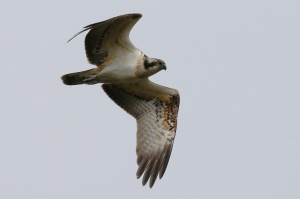
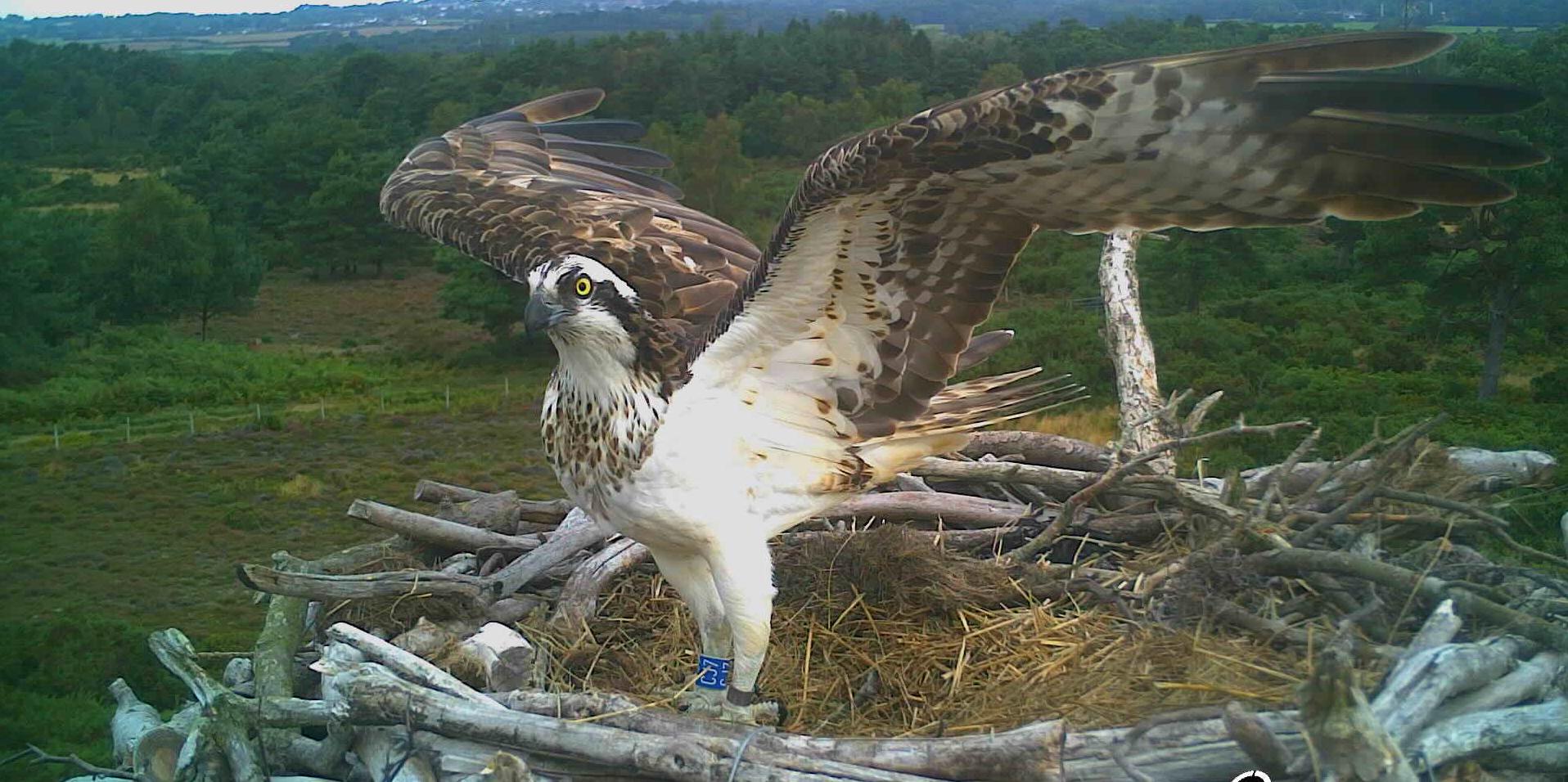
Haematopus ostralegus
Resident
Poole Harbour is the premier area in Dorset for this species. Can often be seen feeding on any mudflat or shingle beach around the harbour, especially in winter. The main high tide roost is on Brownsea lagoon, often with 800+ present and large gatherings of up to 300-400 can be viewed on the shingle bank at Shipstal. Feeding also takes place on the Baiter Park, the football pitches at Whitecliff despite many dogs and on the sports pitches on the south side of Lytchett Bay. Poole Harbour is the main breeding area in Dorset with the bulk of the population historically nesting on Brownsea. Numbers have fluctuated considerably from year to year with a maximum of c40 pairs in 1978, However the numbers of pairs have been in decline over the years, with a range of 5 – 26 per year up to 2006.
A county record was broken with a count of 2034 in Dec 1999. Since then peak numbers have declined and the mean peak count between 2015 and 2019 is now only 955. This reflects a recent trend whereby numbers peak on autumn migration rather than in winter.
While not of national importance Poole Harbour is one of the largest wintering areas on the south coast and a busy terminus for passage birds. In September the first batch of birds arrive, after breeding in Iceland, Scotland, and the north of England. Then as winter progresses Norwegian birds filter down the east coast, adding to the population which peaks between November and January. Robin Ward worked a lot of this out and wrote in the 1989 Dorset bird report that; “the relatively slow fall in numbers of Poole’s Oystercatcher numbers during March is indicative of the presence of Norwegian breeding birds”. His hypotheses were made from a substantial ringing programme during which Britain’s only recovery of an Oystercatcher ringed in Poole and recovered in Greenland was made. He also stated that “over 1500 birds have been ringed in the harbour by Chris Reynolds and Alan Bromby.” A 2nd cal year Oystercatcher was ringed on Brownsea in November 1999 and recovered at Seine France in August 1999. Another was ringed in March 1998 and controlled from Manche, France in July 1999. The longest lived in the harbour was one that was ringed on Brownsea in 1975 and finally found dead tangled in nylon fishing wire also in the harbour 24 years later in November 1999.
All this activity means that we can reckon on 200 to 300 local birds that stay around, many immature, some breeding, and that the winter balance of a thousand to fifteen hundred are migrants.
The last full survey of the breeding birds by McClure and Payne in 1994 showed that the Oystercatchers preferred breeding on the islands around the harbour with at least 25 pairs, most on Brownsea. They stated that“ 7 pairs on Furzey in 1985 and 1994′. Pickess and Day believed this was still the case, and calculated an average of 16 pairs. There were 27 pairs on Brownsea in 2004, but no recent Poole Harbour breeding Oystercatcher surveys has been conducted.
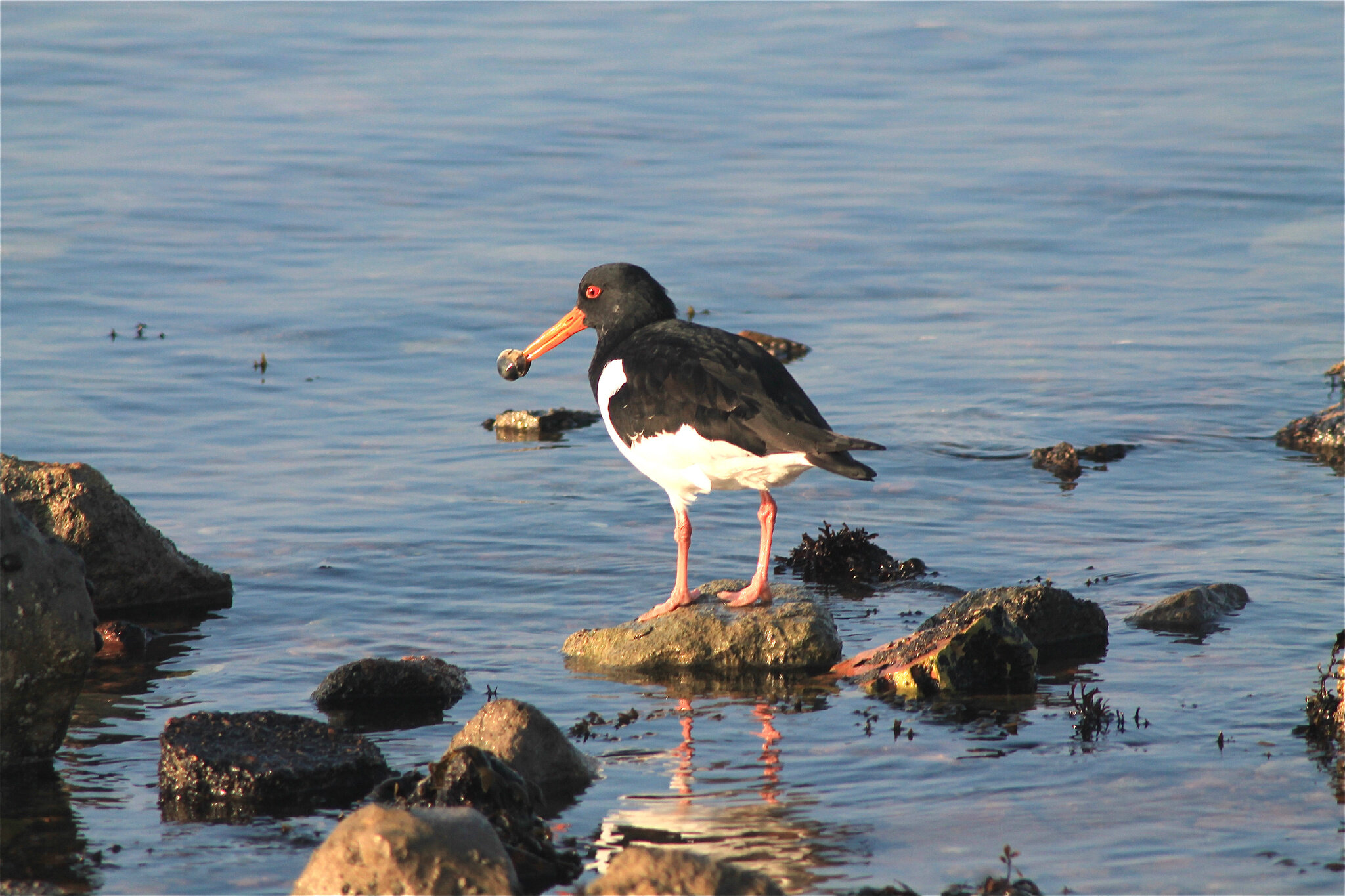
Branta bernicla hrota
Scarce Passage Migrant & Winter Visitor
The first record of this taxa was of five in Brands Bay on 28th March 1994. There were two more at Little Sea on the 4th and 5th November 1995 and one at Middlebere on 16th January 1998 . On the 27th Feb 2002 one was found at Middlebere with 200 Dark-bellied Brents with 1 on 27th Feb 2002 at Middlebere with 200 dark-bellied Brent Geese
Since then between 1 and 4 birds are recorded most winters usually to be found in the large flock of Dark-bellied Brent Geese that visit the harbour. There was a high of 6 at Baiter from 14th -24th Jan 2004 and one summered on the Brownsea Lagoon from 18th May until 16th June and was thought to be a sick bird.
This race of Brent Goose is a scarcer relative of our more familiar Dark-bellied Brent Goose. Pale-bellied Brent Geese breed up in Greenland and Alaska
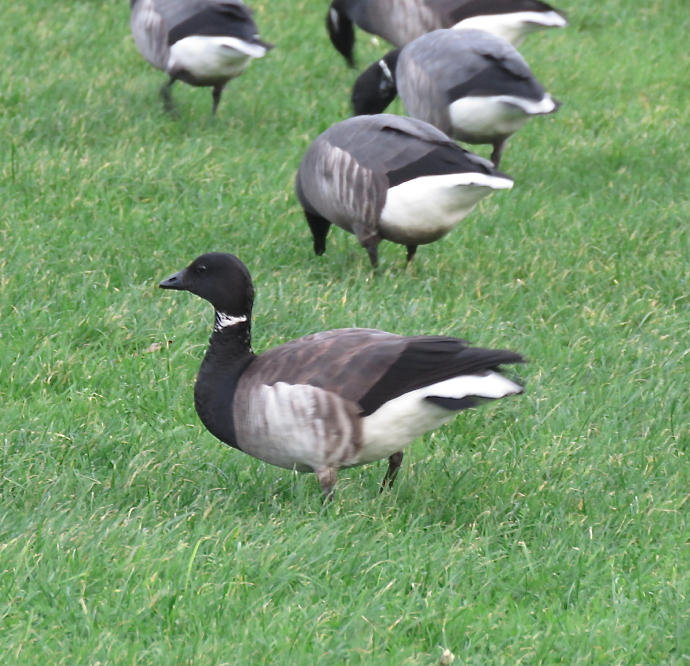
Phylloscopus proregulus
Vagrant
You’ll have to wait until late October and there’s no doubt where the best place is to try and see one (Studland), but with only 3 Poole Harbour records Pallas’s Warbler remains a very rare Poole Harbour bird. If only they could become as frequent as Yellow-browed Warblers.
1 on October 25th 1999 at Pilot’s Point, Studland (Mark Constantine)
1 on October 24th – 26th 2007 at South Beach, Studland (Nick Hopper et al)
1 on October 24th 2013 South Beach, Studland (Nick Hopper et al)
Syrrhaptes paradoxus
Vagrant
Both 1863 and 1888 saw an incredible irruptions of these birds from central Asia. Many thousands occurred in western Europe particularly during 1888. There have only been 6 records in Britain in the last 100 years. The last on Shetland in 1990. There were no Dorset records in 1863 but there were 2 in 1888 and one in Jan 1889. One which was in the harbour…..
6 on 28th May 1888 at Wareham (per Field 09/06/1888)
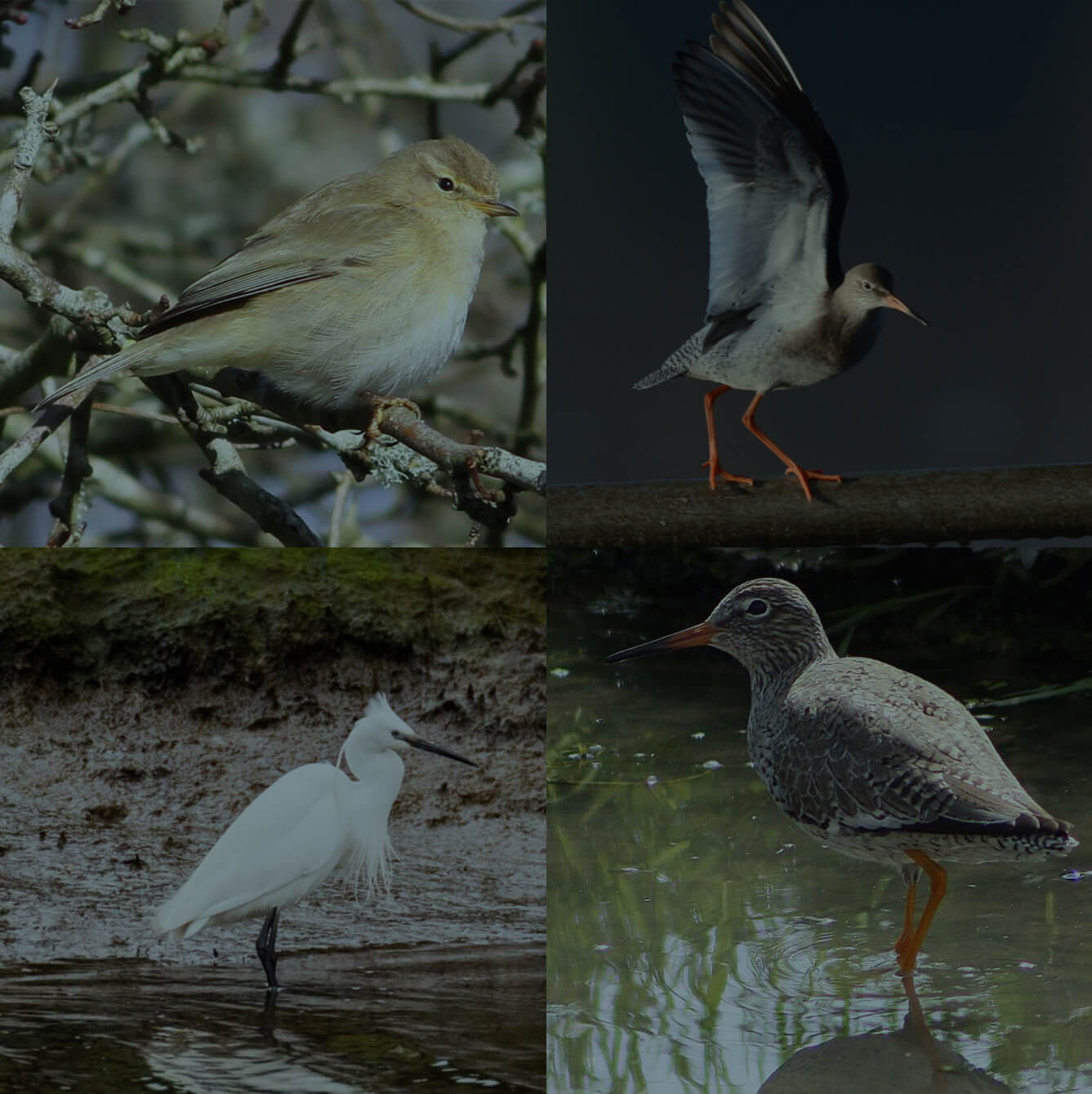
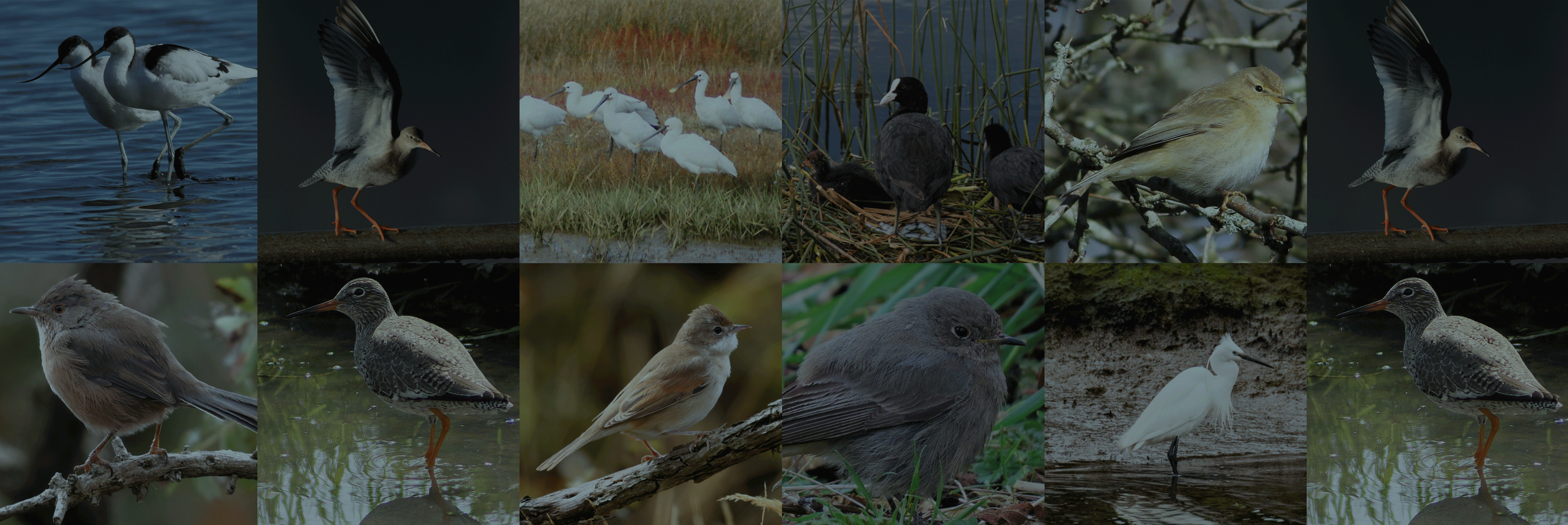
Media
Explore our videos, live wildlife webcams and sound recordings from Poole Harbour
© 2025 Birds of Poole Harbour Registered Charity No. 1152615
